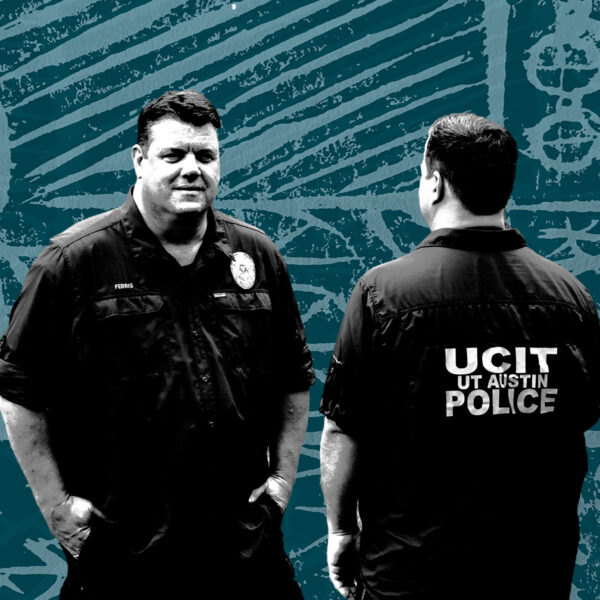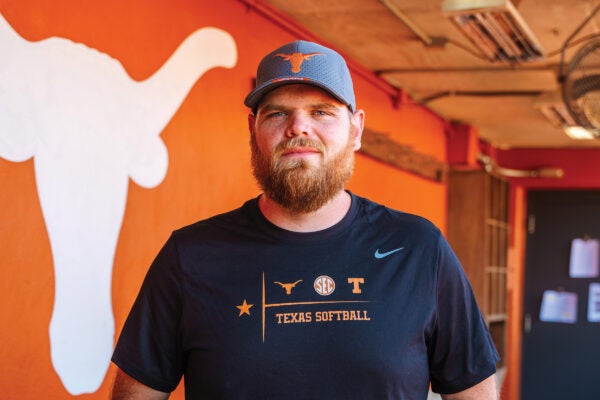The Mental Health Assistance and Response Team is a new program that pairs mental health professionals with officers from the University of Texas Police Department.
When a call comes into UTPD that has a mental health component, a police officer and a licensed mental health counselor from MHART will handle it together. The initiative aims to increase constructive outcomes, says Chris Brownson, associate vice president for student affairs and director of the UT Counseling and Mental Health Center.
“UT has such a strong commitment to providing mental health services to students, especially when they’re in crisis, and doing it in a way that is going to make them feel as comfortable as possible, as safe as possible,” Brownson says. “The idea of pairing a mental health professional with a police officer … is meant to really do that.”
Marla Craig, senior associate director for clinical services at the CMHC, says the program is in the process of hiring two mental health counselors who will work in shifts. The program is meant to support the entire UT community, including faculty, staff and students, she says.
Brownson says the impetus for MHART came in large part from UT students voicing interest in a more creative response approach. He said increased focus in the past year on the intersection of policing and mental health, particularly in communities of color, made this the opportune time to bring a proposal for the program forward.
“For somebody who’s experiencing a mental health crisis, it is scary, hard stop,” Brownson says. “And to add on to that, sometimes having to involve the police for an individual who either they themselves or their community has had negative interactions, or (has) heard tragic stories about those interactions. … It makes it even scarier.”
If we can get the mental health provider connected from the very beginning, there can be times when we will prevent people from going to the hospital.
He says this partnership between a UTPD officer and mental health counselor “might help ease some of that, and make the individual feel more safe and more comfortable during what is often a challenging situation.”
Brownson says the need for MHART is also demonstrated by the high number of mental health calls UTPD and the CMHC receive. In 2020, UTPD handled 541 calls that had a mental health component, slightly down from 551 in 2019. Calls with a mental health element make up the majority of calls UTPD answers.
In the summer of 2020, Brownson formed a committee that included members of UTPD, the CMHC, the Office of the Dean of Students, Student Emergency Services, the Employee Assistance Program and the Victims Advocate Network. After the committee conducted research about other models and considered the unique needs of UT’s community, they put together a proposal that became the pilot for MHART, he says.
Calls made to UTPD that have a mental health element will now be dispatched to both UTPD and MHART counselors. The UTPD officers who go out on the call will primarily be from the department’s University Crisis Intervention Team, or UCIT. The team, formed in January, consists of officers who have additional mental health training.
For example, if someone on campus is concerned that a student is expressing suicidal thoughts, UTPD dispatch would take the call and send both MHART and a UTPD officer to co-respond to the situation and help determine what level of support the student needs.
The MHART counselors are trained to triage a situation and do a risk assessment, which involves talking with the person to determine their level of need or care. “It could be that the person just needed some support and information about community and campus resources, and we can definitely provide them with that,” Craig says.
If the counselor talked to the student and determined a higher level of intervention was needed, they might help transport them to the hospital. In either case, the counselor would follow up with the person, connect them with available resources and continue to check in with them as long as it’s needed to provide support.

Brownson says the committee has many goals for MHART. One is for the program to help with better coordination of care for students, faculty or staff experiencing mental health crises. Another is for MHART to improve communication and coordination between the UT entities providing health care and the hospitals, outpatient facilities and other community mental health agencies that community members use during a crisis.
The committee hopes the program will improve efficiency in responses to mental health calls because counselors are involved early rather than later on, and it will decrease the number of involuntary hospitalizations that are occurring for people in UT’s community. “If we can get the mental health provider connected from the very beginning, there can be times when we will prevent people from going to the hospital,” Brownson says.
The committee also wants the program to increase feelings of safety, trust and fair treatment, especially for those who are from communities or have identities that historically have not had positive relationships with law enforcement, Brownson says. Committee members hope it will decrease repeat encounters with law enforcement and help divert people from the criminal justice system.
He says MHART is meant to go to where the UT community is and is not bound by the geographical boundaries of campus in its response. MHART counselors will also provide education and training to the UT community, “so that our community knows better how to recognize and intervene with somebody who might be experiencing emotional or mental distress,” Brownson says.
Craig points out that MHART can also assist when the CMHC or Employee Assistance Program needs to reach a UT community member for a welfare check, which occurs when there is concern about the safety and well-being of the person. She says she’s looking forward to having mental health counselors involved more in the community, rather than being limited to the offices that provide mental health services.
“There were so many times when I wished a counselor could go to the person’s or student’s home or location,” Craig says. “I think that definitely can have a whole different outcome.”



